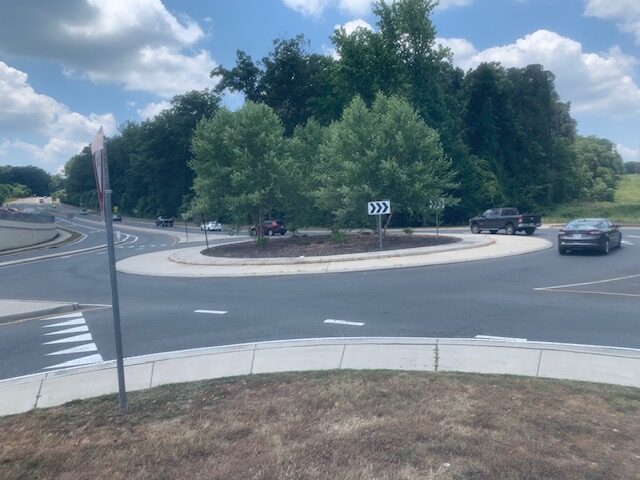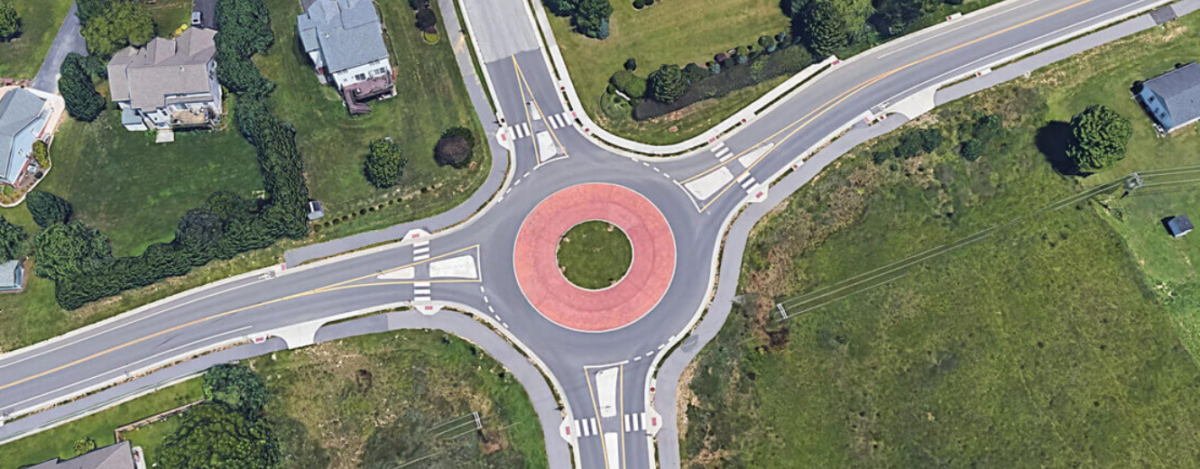
Roundabouts are becoming more common nationally, statewide, and regionally. Traffic engineers say they are less expensive to construct and safer for motorists.
There’s been a change in highway construction over the last decade that could make travel safer and less stressful.
Traffic engineers across the country, the state, and the region are turning to the “roundabout” more and more as a way to move traffic through intersections faster and more safely.
As traffic increases, they are becoming more common in central Virginia.
Rob Weber, a traffic engineer with the Virginia Department of Transportation, says the roundabout, in addition to being safer, is often less expensive in the long run and faster to build.
As of this month, there are 284 roundabouts in operation in Virginia, and another 76 in development.
Weber says roundabouts are cheaper and easier to maintain than four-way stops or traffic lights, and they limit the number of points where vehicles cross paths, thereby reducing the potential for right angle and head on crashes.
Roundabouts differ from the rotary intersection, which is common across New England and brings together four or five roads at a huge circle. Drivers go around the circle to make typical left or right turns.
The rotary forces drivers to yield to traffic, requiring them to stop for cars in the circle. That slows down traffic.
Roundabouts also differ from large traffic circles like the ones in Washington, D.C, which usually have traffic lights or stop signs.
Some motorists have trouble maneuvering through a roundabout at first, not realizing they usually do not have to stop at all. But Weber says it’s not difficult if drivers follow the signs that are posted at the approach to the intersection.
“At a standard intersection, you have cars crossing at 90 degrees and those can lead to very devasting crashes,” Weber says. “In a roundabout, crashes are more like a sideswipe.”
That means crashes that cause injuries are significantly reduced in roundabouts.
Weber spoke to the Advance at the roundabout at Fall Hill Avenue and Mary Washington Hospital Boulevard in the middle of a hot weekday afternoon.
In the span of an hour, only one car came to a full stop entering the roundabout, and that was just briefly. The rest ran smoothly through at a good speed (most roundabouts have a speed limit of 35 mph).
That’s the main advantage of a roundabout—they move traffic along and lower driver frustration, Weber said.
“I would say traffic engineering is the intersection of physics and psychiatry,” he said.
According to VDOT, the typical roundabout can be constructed for about $700,000 if the existing intersection footprint is big enough. By contrast, a four-way intersection with traffic lights and turn lanes can cost $2 million.
Roundabouts also save drivers money on gas and cut down on pollution from exhaust because there is no idling.
There are 20 roundabouts already in use, under construction, or in planning phases in the Fredericksburg region.
VDOT does receive complaints from the community when a roundabout is proposed, but Weber says those complaints usually go away once the benefits are evident to motorists.


Three relatively new roundabouts are already operating in Stafford County, and an example of a new traffic control technique called a “modular roundabout” is due for completion this summer at the intersection of Banks Ford Parkway and Celebrate Virginia Parkway.
It is being constructed with prefabricated parts on an existing intersection footprint, in a short period of time to see if it is the right traffic control tool for that spot. The whole roundabout can be removed or made permanent at a later date.
Four more roundabouts are in development in Stafford:
- Mountain View Road, Stefaniga Road, and Lightfoot Drive
- Shelton Shop Road at Mountain View Road/Honey Lane
- Shelton Shop Road and Courthouse Road
- Shelton Shop Road and Winding Creek Road.
There are now seven roundabouts in Fredericksburg City and two have been recently completed in Caroline County.
In Spotsylvania County, VDOT is constructing a new roundabout at Mudd Tavern Road near the Route 2092 access road, designed to detour traffic away from the busy intersection at U.S. 1 near where the Kalahari Water Park is under construction.
Also in Spotsylvania, a roundabout is under construction at Old Dominion Parkway and Lee Hill School Drive. It should be completed later this year.
The best advice for navigating a roundabout is to slow down, follow the signs and squeeze slowly into traffic in the circle without stopping.
by Hank Silverberg
CORRESPONDENT


